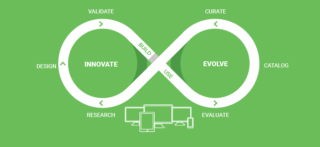Hacking Sustainability an innovation driver
In the field of software, a corner has been turned from re-inventing wheels (custom code) to building and leveraging code libraries. Not only has this brought massive efficiency gains in reduced development cycles, it has also yielded in value added community contribution, re-use and improvement, harvesting, and general ease with natural progression. In short… the field has graduated from a state of waste to a state of sustainability and progress.
As we turned the corner of 2017, I walked on the sands of what’s called “Trash Beach” – the southernmost point of the Big Island of Hawaii. Situated in just the right place to capture and hold any plastics that escape the North Pacific Gyre. Fishing nets, bottles, toys, packaging, and general detritus.
It’s one thing to look at photos and talk about how horrible it is… but it’s so much more visceral to see it stretch beyond your own vanishing point looking up the shoreline.
Leaving this site… I find that this beach is a metaphor… an accumulation of our collective rejection of sustainability, conveniently tucked just out of reach. In fact, the road to this stretch of beach in South Point cannot be accessed without 4 wheel drive with ample clearance. Any tourist in a sedan would be stuck on the rocks attempting to get here. Truly out of site, and out of mind.
In contemplating waste and carelessness moving to sustainable efficiencies, one can look to lessons found in software development. One of the tenants of Agile development is to “shine a light in dark corners, and by doing so, eliminate the problem”. When a problem can no longer hide, it’s power to exist diminishes.
How does this happen?
In software, waste (time/money) comes at shareholder/investor costs and at the painful expense of engineers and managers. This incentivizes leadership and collective focus to triage the problem. Our species has a penchant for problem-solving, but we’re also creatures of comfort and convenience which at present, in particular with our current state of waste, is diametrically opposed. We make sacrifices in our individual lives and as a collective, where we are yet to find the right incentive.

Over the past 8 years, I’ve worked in government working through technology challenges the contracting game has introduced. In government, they look for the cheapest bids with the intention of saving the taxpayer money… but in the end, this has lead to tremendous amount of waste and inefficiency. Organizations like the Sunlight Foundation are looking closely as these challenges. the USDS is actively trying to attack the problems. But we need to go further – COTR’s need the training necessary to better understand how to buy technology solutions (with an eye on sustainable management). And contractors actively engaging the federal government have a responsibility to educate them.
2017 marks a corner. I’m challenging myself to triage needless waste in my day-to-day life – material, time, energy, and cost… in my personal and professional life. In the spirit of Mark Zuckerberg’s “annual personal challenge”, I plan to end this year with several intentional life and business growth-hacks and engineered solutions to tackle waste and move towards sustainability.
I’m inspired by Joi Ito’s Whiplash: How to Survive Our Faster Future – Sustainable innovation is more than just throttling R&D. It takes understanding your present context and your past with an eye on unintended consequences.
The field of UX is ripe with opportunity to drive more sustainable practices in research, innovation, and design management tools. I’m excited to work with Limina.co to attack these opportunities!